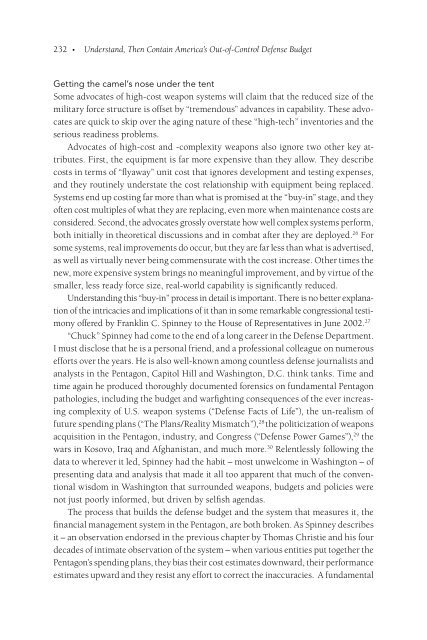Americas Defense Meltdown - IT Acquisition Advisory Council
Americas Defense Meltdown - IT Acquisition Advisory Council
Americas Defense Meltdown - IT Acquisition Advisory Council
Create successful ePaper yourself
Turn your PDF publications into a flip-book with our unique Google optimized e-Paper software.
232 • Understand, Then Contain America’s Out-of-Control <strong>Defense</strong> BudgetGetting the camel’s nose under the tentSome advocates of high-cost weapon systems will claim that the reduced size of themilitary force structure is offset by “tremendous” advances in capability. These advocatesare quick to skip over the aging nature of these “high-tech” inventories and theserious readiness problems.Advocates of high-cost and -complexity weapons also ignore two other key attributes.First, the equipment is far more expensive than they allow. They describecosts in terms of “flyaway” unit cost that ignores development and testing expenses,and they routinely understate the cost relationship with equipment being replaced.Systems end up costing far more than what is promised at the “buy-in” stage, and theyoften cost multiples of what they are replacing, even more when maintenance costs areconsidered. Second, the advocates grossly overstate how well complex systems perform,both initially in theoretical discussions and in combat after they are deployed. 26 Forsome systems, real improvements do occur, but they are far less than what is advertised,as well as virtually never being commensurate with the cost increase. Other times thenew, more expensive system brings no meaningful improvement, and by virtue of thesmaller, less ready force size, real-world capability is significantly reduced.Understanding this “buy-in” process in detail is important. There is no better explanationof the intricacies and implications of it than in some remarkable congressional testimonyoffered by Franklin C. Spinney to the House of Representatives in June 2002. 27“Chuck” Spinney had come to the end of a long career in the <strong>Defense</strong> Department.I must disclose that he is a personal friend, and a professional colleague on numerousefforts over the years. He is also well-known among countless defense journalists andanalysts in the Pentagon, Capitol Hill and Washington, D.C. think tanks. Time andtime again he produced thoroughly documented forensics on fundamental Pentagonpathologies, including the budget and warfighting consequences of the ever increasingcomplexity of U.S. weapon systems (“<strong>Defense</strong> Facts of Life”), the un-realism offuture spending plans (“The Plans/Reality Mismatch”), 28 the politicization of weaponsacquisition in the Pentagon, industry, and Congress (“<strong>Defense</strong> Power Games”), 29 thewars in Kosovo, Iraq and Afghanistan, and much more. 30 Relentlessly following thedata to wherever it led, Spinney had the habit – most unwelcome in Washington – ofpresenting data and analysis that made it all too apparent that much of the conventionalwisdom in Washington that surrounded weapons, budgets and policies werenot just poorly informed, but driven by selfish agendas.The process that builds the defense budget and the system that measures it, thefinancial management system in the Pentagon, are both broken. As Spinney describesit – an observation endorsed in the previous chapter by Thomas Christie and his fourdecades of intimate observation of the system – when various entities put together thePentagon’s spending plans, they bias their cost estimates downward, their performanceestimates upward and they resist any effort to correct the inaccuracies. A fundamental


